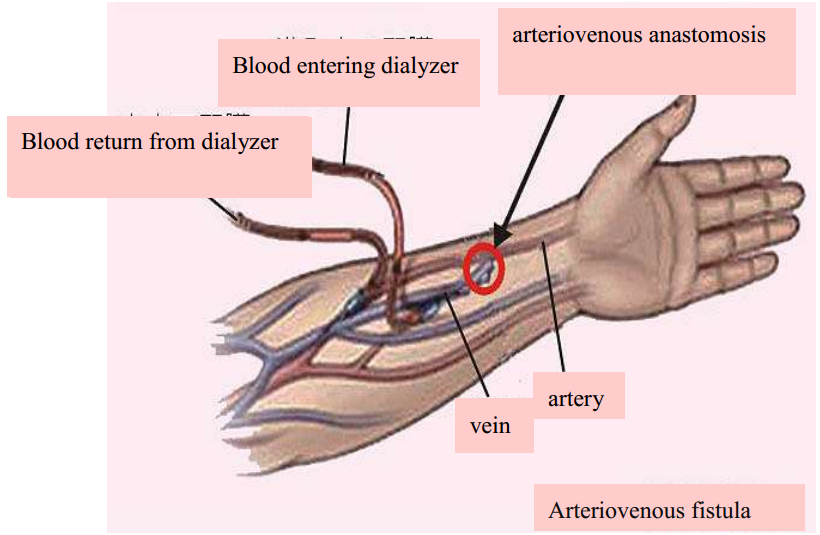【Learning points】
- Arteriovenous catheters are the lifeline for blood patients and must maintain normal function.
- You should develop the habit of checking blood vessels daily and evaluate intravascular flow regularly.
- The arteriovenous catheter arm is prohibited from measuring blood pressure, giving injections, drawing blood, and lifting heavy objects.
- If hematoma occurs due to intermittent use, ice compress can be used after the hematoma occurs, and hot compress can be used after 24-36 hours.
I.Purpose
Establishing the vascular access needed for long-term hemodialysis.
II.Surgical Overview:
Arteriovenous fistula (AVF) surgery is done by a cardiothoracic surgeon to create an access that is made by joining an artery and vein in your arm. This procedure increases blood flow and dilate the veins. Typically, surgery is performed on the non-dominant arm (usually the left hand). Refer to the anatomical diagram of the arteriovenous fistula (Figure 1).

III. Preoperative Care for Arteriovenous Fistula Surgery:
- A preoperative evaluation of the patient’s blood vessels and a discussion of surgical treatment will done by a cardiothoracic surgeon. The physician will then decide whether to use the patient's own blood vessels or to implant artificial blood vessels. Postoperative care is similar for both types of vascular surgeries. The cardiothoracic surgeon will schedule the surgery date and determine the method. 1
- The arm prepared for surgery should refrain from drawing blood , intravenous injections and blood pressure measurements.
- If there are no specific requirements before surgery, normal dieting is allowed. However, if the procedure involves general anesthesia, it is important that one day before surgery you should refrain from eating and drinking after midnight.
- Necessities after surgery include: one triangular bandage, a soft tennis ball to train the arteriovenous fistula, and two tourniquets for post dialysis treatment.。
IV.Postoperative Care for Arteriovenous Fistula Surgery:
- Keep the wound dressing clean and dry.
- Elevate the arm with a pillow when lying down, to keep it at the same level as the heart. This helps promote blood circulation to the surgical site and prevents swelling in the extremities.
- If the wound shows redness, swelling, heat, oozing blood or if the fingers of the affected limb become swollen, numb, painful or discolored, inform healthcare professionals immediately. Do not self-administer medication or apply pressure to the surgical wound.
- After the cardiothoracic surgeon evaluates the status wound healing, the hand gripping exercises can begin the third day after surgery. The exercise involves squeezing a ball with the hand, holding the grip for five seconds (counts silently), and then releasing it. Repeat these movements for approximately 15 minutes, three to four times a day (refer to Figure 2).
Figure 2 Grip exercise. Figure Source: https://goo.gl/6nvD58
- Keep the wound dressing dry and avoid contact with water to prevent infection. If there are stitches, the physician will remove them approximately 10-14 days after the surgery, and wound closure strips will be applied to the wound
V. Rehabilitation and Prevention of the Complications:
- The wound must remain clean and maintain personal hygiene. Avoid activities such as drawing blood, injections, or measuring blood pressure in the surgical arm. Refrain from lifting heavy objects, 2 impacting heavily, bending joints, wearing tight clothing, or putting pressure on the wound with accessories. Do not place the access arm under the pillow to prevent disruption of blood flow or vascular obstruction.
- After each dialysis session, cover the wounds with gauze and use tourniquets to apply pressure for 5 to 10 minutes. After gently releasing the tourniquet, continue applying pressure for approximately 1-2 hours (duration may vary from person to person) to prevent bleeding.
- If a hematoma (pain and bruising) occurs due to a puncture, then apply ice to the affected area immediately to prevent further bleeding. After 24-36 hours switch to warm compresses (doing so after a doctor's examination).
- Maintain good personal hygiene to prevent wound infection. Do not scratch your skin or pick the scab. Keep the arm clean and the surrounding skin intact after the wound has healed.
VI. Post-discharge precautions:
- After discharge, it is important to have a daily habit of checking the blood vessels. Normal fistula function can be felt with a pulsating sensation and a "swishing" sound (indicating functionality). Observe any changes in skin color (indicating inflammation). If there is redness, swelling, warmth, pain, or discoloration at the puncture site, seek medical attention immediately. Do not self-administer medications or apply topical treatments without consulting a healthcare professional.
- Avoid lifting heavy objects with the access limb. Avoid sleeping on the access arm.
- If symptoms of infection appear or you lose the pulsation or swishing sound, seek immediate medical attention.
VII. Conclusions:
Arteriovenous fistula is the most frequently prioritised vascular access for long-term hemodialysis. Vascular access is the lifeline of end-stage renal disease patients. Post arteriovenous fistula surgery, the wound healing period, the reduction of postoperative swelling in the upper limb, and the maturation of the access are critical. The proper functioning of the access significantly affects the quality and effectiveness of hemodialysis. Therefore, taking good care of the vascular access is of utmost importance.
VIII.References
- 許嘉芳、宋聖芬、龔怡心(2021)・照護一位糖尿病腎病變病 3 人首次透析之護理經驗・高雄護理雜誌,38(1), 122-132。https://doi.org/10.6692/KJN.202104_38(1).0011
- 歐世祥、李柏蒼(2021)・血管通路建立與照護・腎臟與透析, 33(2),63-67。 https://doi.org/10.6340/KD.202106_33(2).0002
- 謝至同、楊智宇(2020)・透析血管通路的監測・腎臟與透析, 32(4),224-228。 https://doi.org/10.6340/KD.202012_32(4).0011
Quiz
A quiz to help you understand
評語
統計結果不開放
請登入後才可以評分